Dr. Utr. Iur.
Frank
Van den Broeke

To book an authorised guided tour with me: .... Click here
Wine & Dine: ... Click here
Where to buy your tickets ... ? Click here
Me Too !
Position of Women in New Testament: pro & contra
I would like to start this article with and extract of the letter of St.Paul to the Ephesians 5, 21-33
21 Be subject to one another out of reverence for Christ.
22 Wives should be subject to their husbands as to the Lord,
23 since, as Christ is head of the Church and saves the whole body, so is a husband the head of his wife;
24 and as the Church is subject to Christ, so should wives be to their husbands, in everything.
25 Husbands should love their wives, just as Christ loved the Church and sacrificed himself for her
26 to make her holy by washing her in cleansing water with a form of words,
27 so that when he took the Church to himself she would be glorious, with no speck or wrinkle or anything like that, but holy and faultless.
28 In the same way, husbands must love their wives as they love their own bodies; for a man to love his wife is for him to love himself.
29 A man never hates his own body, but he feeds it and looks after it; and that is the way Christ treats the Church,
30 because we are parts of his Body.
31 This is why a man leaves his father and mother and becomes attached to his wife, and the two become one flesh.
32 This mystery has great significance, but I am applying it to Christ and the Church.
33 To sum up: you also, each one of you, must love his wife as he loves himself; and let every wife respect her husband.
This extract for centuries determined the position of the women in our society, and still does in many other civilizations. It is always dangerous to read the Bible partially. If you take only Ef. 5:22, a women should be subject to her husband. When the topic of anyone being submissive comes up, people often cringe. Of course people, men and women alike, rely on Ephesians 5:22 to explain away abusive or unhealthy relationships. Saint Paul, who was a roman citizen, of course thought in terms of the Roman Law system: the Pater Familias had the full power of life and death over his wife: she was his property. This line shows us the physically subjection of a wife to her husband. The Roman law depict the Christian household as a hierarchically ordered social unit: the same was with as with the relationship between children and parents, slaves and masters. Always a relationship of subordinates and superiors. Was this comment made in order of responding to accusations that Christianity undermined the social fabric by advocating equality among its adherents ? There is also written: "There is neither Jew nor Greek, there is neither slave nor free, there is neither male nor female, for you are all one in Christ Jesus." (Gal. 3:28) But, on a first view, a women should be subject to her husband.
But then is coming a turn-around: “Husbands should love their wives, just as Christ loved the Church and sacrificed himself for her”. What in the beginning is a physical submission of a women to men is lifted to a higher level where the man spiritually have to submit his wife in love. As a conclusion we can say that the submission of man to a women is a more challenging task that the physically submission of a women towards a man.
1 Tim 3:8 Similarly, deacons must be respectable, not double-tongued, moderate in the amount of wine they drink and with no squalid greed for money.
9 They must hold to the mystery of the faith with a clear conscience.
10 They are first to be examined, and admitted to serve as deacons only if there is nothing against them.
11 Similarly, women must be respectable, not gossips, but sober and wholly reliable.

The Compendium of the Social Doctrine of the Church tackles the notion of equal dignity between the sexes. It embraces the obvious reality that there are differences between man and woman. Yet it maintains the principle that the categories of man or woman are irrelevant in the area of equal dignity. We can say man is in the image of God. We can say woman is in the image of God. Since man and woman are both made in the image of God, they are creatures of equal dignity. In the chapel of san Zenone in the church Santa Prassede we see clearly the importance of women. But what is the role of a women in the hierarchy of the Church? Saint Paul in the letter to his friend Timotheos is listing the requirements for being a deacon.
Since the qualities required of the “women” are virtually identical to those listed in vv. 8-9 for men, and since there is no similar reference to the wives of bishops or elders, the author probably refers here to women deacons. (mostly widows). Those lines strengthens the impression that the “enrolled widows” constituted a specific office within the community.
1 Tim 5:11 Do not accept young widows because if their natural desires distract them from Christ, they want to marry again,
12 and then people condemn them for being unfaithful to their original promise.
14 I think it is best for young widows to marry again and have children and a household to look after, and not give the enemy any chance to raise a scandal about them;
17 Elders who do their work well while they are in charge earn double reward, especially those who work hard at preaching and teaching.
Acts 18:24 An Alexandrian Jew named Apollos now arrived in Ephesus. He was an eloquent man, with a sound knowledge of the scriptures, and yet,
25 though he had been given instruction in the Way of the Lord and preached with great spiritual fervour and was accurate in all the details he taught about Jesus, he had experienced only the baptism of John.
26 He began to teach fearlessly in the synagogue and, when Priscilla and Aquila heard him, they attached themselves to him and gave him more detailed instruction about the Way.
Robert A. Wild, S.J. in the New Jerome Biblical Commentary supports the idea that women in the Pauline Church held responsible positions and are depicted as preaching (1 Cor 11:5) and teaching (Acts 18:26). And in the Bible we have a few examples:
Rom 16:1 I commend to you our sister Phoebe, a deaconess of the church at Cenchreae;
2 give her, in the Lord, a welcome worthy of God's holy people, and help her with whatever she needs from you -- she herself has come to the help of many people, including myself.
3 My greetings to Prisca and Aquila, my fellow-workers in Christ Jesus,
1 Cor 16:19 The churches of Asia send their greetings. Aquila and Prisca send their best wishes in the Lord, together with the church that meets in their house.
Of course all those biblical text let us reflect on the possibility of women priesthood. In 1977 the Pontical Biblical Commission made a report. The PBC member scholars voted 17-0 that the New Testament does not settle the question in a clear way, once for all; In voting 12 against 5 that neither Scripture nor Christ’s plan alone excluded the possibility.
A new opening was made by pope Francis I in 2016 when he installed Study Commission on the Women's Diaconate and here a latest update in 2019.
An interesting article in 2019 by Phyllis Zagano who is a member of the Pontifical Commission for the Study of the Diaconate of Women. By clicking on her image, you can hear her comment in YouTube in the program: “Subject Matters” of 2017.
I am quite sure that the Pontifical Biblical Commission on the Women Diaconate made a good study of how the position of women was in the first centuries. Myself, having a degree in both the laws, Civil and Canon Law, my task here is not make conclusions of their work or pretend to know to which conclusions Pope Francis I will come. But during my studies, I learnt something about the position of the women, as well in Roman Law as in the Codex Iuris Canonici. Here on the left, we have an image of how the emperor Justinianus emanate the civil law in his codex in the 6th century.
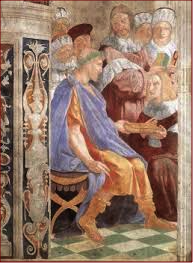


Civil Law
Signature room Raphael
Canon Law
Signature room Raphael
Theodora I
San Vitale basilica Ravenna
How things changed after Constantine

His wife, the empress Theodora I played an important role in defining the role of women. She was a champion of women’s rights. She had laws passed which prohibited the trafficking of young girls and changed existing laws impacting divorce to give more benefits to women. Until that time a women was under the full power of the Paterfamilias.
But maybe, the Pius Christian museum of the Vatican Museums can give a little punch in the back that supports the conclusions of the Pontifical Biblical Commission on the women diaconate. Walking almost daily through it, I noticed how the iconography changed over the years. On the one hand we have the devotion of the early church, a movement with a lot of references to the old testament that would alluding as prophecies of Jesus. Little by little, we will see, the movement is becoming an institute. And when the emperor moved the capital to Constantinople, the pope took over the role of the emperor. People called him “Papa”, the same honor title that the emperor Augustus was reluctant to accept: Pater Patriae: Father of the Fatherland. His successors had no problem with that,
and finally also the Holly Father took that title: “Papa, Pope, Paus, Pape ..” As we know the empire was divided in provinces, a structure that the church took over. And when the the emperor was dressed in purple, it became also the color for Popes and cardinals, just like the use of the pallium.
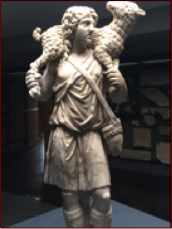
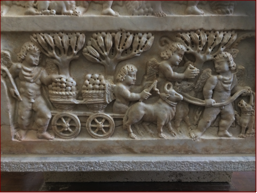

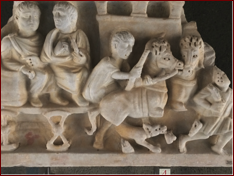
When in 1854 Giovanni Battista de Rossi found back the catacombs of Callisto, he found at the entrance the beautiful statue of the Good Shepherd.
A lot of scenes are bucolic and scenes where everything is peaceful and in harmony would give us an idea of how heaven could be. The early apostles (Peter and the 12) were local fisherman. Jesus will make them fisher of man. Jesus is the caretaker who even will save the last lost sheep. In this early period we have also scenes of how the early christians hold their feasts, agape. Ordinary people eating and drinking.

Ghirlandaio
The Vocation of Andrew and Peter
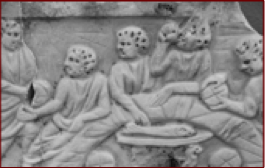
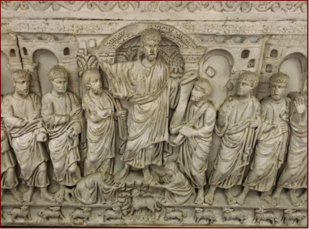
After Constantine, we don’t see anymore the good shepherd. And the apostles just made promotion and now they are dressed like senators with a book roll in their hands while Jesus as a King is sitting on the throne !
But there are more changes: We all know that Jesus on Palm Sunday entered in triumph in Jerusalem on a donkey. After Constantine, the iconography changed. From now onwards, Jesus is not anymore a simple good shepherd, but the King of Heaven, ruling over his (spiritual) empire.
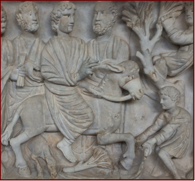
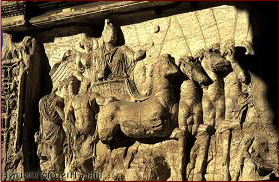
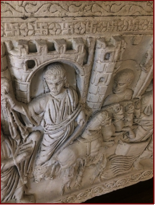
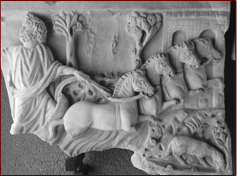
The emperor Titus come in triumph in Rome (arch of Titus)
Jesus comes in triomph in Jerusalem, not anymore on a donkey, but with 4 horses
But the most shocking is the role of the women ….. In the early iconography it seems that man and women were equal.
Role of the women in the history: the Hebrew culture


In the Hebrew culture, Judaism, we have in history some women who played very important roles such as Sarah, Rebecca, Ester, Deborah (judge), Holdall (prophet), (2 Kings 22:14) Abigail, Rachel, Leah, Miriam. While the husband was clearly the boss, each expected love from the other and a wife had the legal right to support. They were treated equal to men. They got different responsibilities, and sometimes those of women were more important than men.
The role of a women in traditional Judaism has been grossly misrepresented and misunderstood. The position of women is not nearly as lowly as many modern people think; in fact, the position of women in halakhah (Jewish Law) that dates back to the biblical period is in many ways better than the position of women under American and European civil law as recently as a century ago.

San Zenone Chapel Rome: 4 women
Only quite recent, the position of the women in the world is changed a lot. Specially when you see from how far we are coming. When I did my law studies, I was amazed that my country, Belgium, was one of the last western countries where women were allowed to vote for the first time in parliamentary elections. We speaking of June 26, 1949. At that age, my grandmother was already over 40 years old. Australia was the first country where in 1903 all women were allowed to vote. Passed by Congress June 4, 1919, and ratified on August 18, 1920, the 19th amendment granted women the right to vote. Although legally entitled to vote, black women were effectively denied voting rights in numerous Southern states until 1965.
In England on November 21, 1918: the Parliament (Qualification of Women) Act 1918 was passed, allowing women to be elected into Parliament. 1928: Women received the vote on the same terms as men (over the age of 21) as a result of the Representation of the People Act 1928.
In the Jewish tradition, women had the right to buy, sell, and own property, and make their own contracts, rights which women in Western countries (including America) did not have until about 100 years ago. In fact, Proverbs 31:10-31, which is traditionally read at Jewish weddings, speaks repeatedly of business acumen as a trait to be prized in women (v. 11, 13, 16, and 18 especially).
The equality of men and women begins at the highest possible level: G-d. In Judaism, unlike traditional Christianity, G-d has never been viewed as exclusively male or masculine. Judaism has always maintained that G-d has both masculine and feminine qualities. As one Chasidic rabbi explained it to me, G-d has no body, no genitalia, therefore the very idea that G-d is male or female is patently absurd. We refer to G-d using masculine terms simply for convenience's sake, because Hebrew has no neutral gender; G-d is no more male than a table is.
Both man and woman were created in the image of G-d. According to most Jewish scholars, "man" was created in Gen. 1:27 with dual gender, and was later separated into male and female.
The Tetragrammaton is the name of God. The four consonants: Yod, Hey, Vav, Hey (JHWH) are always there (Exodus 3,14) in the name of God. The masoretes in the 13th century started causing the confusion by writing vocals underneath. And so you can pronounce it once "Jahweh" and the next time "Jehovah", and that all when the Hebrew people are saying "Adonai", a word that has nothing to do with those four letters, because you can't pronounce the name of God. He is just what He is and therefore invariable: God is everything: man, women, teacher, shepherd, creator, judge … and we can go on.
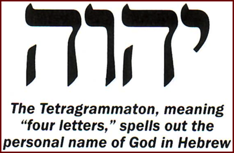
According to traditional Judaism, women are endowed with a greater degree of "binah" (intuition, understanding, intelligence) than men. The rabbis inferred this from the fact that woman was "built" (Gen. 2:22) rather than "formed" (Gen. 2:7), and the Hebrew root of "build" has the same consonants as the word "binah." It has been said that the matriarchs (Sarah, Rebecca, Rachel and Leah) were superior to the patriarchs (Abraham, Isaac and Jacob) in prophecy. Women did not participate in the idolatry regarding the Golden Calf. Some traditional sources suggest that women are closer to G-d's ideal than men.

Women have held positions of respect in Judaism since biblical times. Miriam is considered one of the liberators of the Children of Israel, along with her brothers Moses and Aaron. One of the Judges (Deborah) was a woman. Seven of the 55 prophets of the Bible were women (they are included in the list of biblical prophets).
Women in the gospels and the letters of Saint Paul

Biblically, in the gospels, we know the importance of Mary and of the women that Jesus met. I always wondered myself how the niece of the emperor, Domitila Flavia, got converted when men were not allowed in the women-rooms of the palace.
Isn’t it possible that when the apostles were send out 2 by 2, it was one man and one woman? As we can see in the sarcophagus above, a man is explaining and teaching to men, while a woman is explaining the script to women.
“After this he journeyed through towns and villages preaching and proclaiming the good news of the kingdom of God. The Twelve accompanied him, and also some women… Mary called the Magdalene,….Joanna, the wife of Herod's steward Chuza, Susanna, and many others who were assisting them out of their means.”





John, 20:15 Jesus said to her, 'Woman, why are you weeping? Who are you looking for?' Supposing him to be the gardener, she said, 'Sir, if you have taken him away, tell me where you have put him, and I will go and remove him.'
16 Jesus said, 'Mary!' She turned round then and said to him in Hebrew, 'Rabbuni!' -- which means Master.
17 Jesus said to her, 'Do not cling to me, because I have not yet ascended to the Father. But go to the brothers, and tell them: I am ascending to my Father and your Father, to my God and your God.'
18 So Mary of Magdala told the disciples, 'I have seen the Lord,' and that he had said these things to her.
The importance of this extract of the gospel of St. John is the missionary activity: Jesus tells us: go and tell the world. But the first who has to deliver the message of the resurrection is a woman: Mary Magdala !! It was she who received the order: Go and tell it to the brothers ! In the tombstones above, you can see clearly that a women is explaining the bible to men. The first missionary after the resurrection of Jesus was a women !
Rom 16:1 I commend to you our sister Phoebe, a deaconess of the church at Cenchreae;
2 give her, in the Lord, a welcome worthy of God's holy people, and help her with whatever she needs from you -- she herself has come to the help of many people, including myself.
3 My greetings to Prisca and Aquila, my fellow-workers in Christ Jesus,
1 Cor 16:19 The churches of Asia send their greetings. Aquila and Prisca send their best wishes in the Lord, together with the church that meets in their house.

Five historic women deaconess: You would be surprised is you are seeing the whole list of many women who became deaconess (from the time of Jesus until the 6th century) Click on the image for the full list.
• Phoebe was a leader of the Church at Cenchrae and probably carried Paul’s letter to the Romans (Romans 16:2).
• St. Macrina was the leader of the women’s monastic community at Annisa and was renowned among the laity and clergy alike as a teacher of the Word and defender of Christian doctrine.
•St. Olympias was a fourth century deacon and a friend and patron of St. John Chrysostom. As Bishop of Constantinople, John put her in charge of all the deacons assigned to the great basilica of Hagia Sophia.
• Dionysia was a fourth century wife and mother who overcame several crises and was ordained deaconess of the cathedral at Melitene, Armenia.
• St. Radegund was a sixth century queen and deacon who founded a monastery at Poitiers where she served as the spiritual guide.
But there are also many other women who played important roles: Let’s not forget Saint Monica, the mother of saint Augustine. It was her teaching and her example that converted her son, saint Augustine.

Saint Monica
Basilica Saint Agustine Rome
Position of Women in the Church after Constantine left Rome

Unfortunately, after the Church of Rome and the popes overtook the Roman empire, also the Roman law system was applied within the Church. And women, who had in the beginning an important role within the hierarchy of the Church, are diminishing until disappearing from the system. And suddenly, when the good shepherd became King in Heaven, a donkey was replaced by a chariot with 4 white horses and fishermen became senators … the position of women within the church changed. From having a very important role in the early evangelization, they got reduced to a serving position. Images can tell us more than words can do. Judge by yourself.


Now the woman is laying at the feet of the Lord and in the image above, a women is even smaller depicted than the male children ...
The popes, ruling by the roman law system, took also over the position of women in the roman society. The Paterfamilias is the absolute ruler in the family with the power of life and death over his wife, children and slaves.
The autonomy of women was totally reduced, and they were confined to the inner circle of the household.
It is almost painful to see how women are becoming “serves, servants”.



If there is a moment in the history to say “Me too !”, than now is the moment. Our understanding of the dignity of women … (unfortunately after many scandals of sexual harassment), woke also up the Catholic Church.
21st Century: Pope Benedict XVI & Francis I

If I could, I would like to insert the whole speech of 2007 of Pope Benedict XVI, who claimed that women are “Anything other than secondary !” It was a catechetical talk during the general audience, which highlighted the extent of collaboration and involvement played by women in the life of Jesus and in the first days of the church.
In his televised sit-down with German media, Papa Ratzinger said he was keen "to rejoice when the female element achieves the fully effective place in the Church best suited" to what he called "their energy and strength... their superiority... what I’d call their 'spiritual power.'" The strength and the role of the theologian, Cardinal Ratzinger, for years the head of the Congregation of faith, laid that he had to find a balance between movements that would like to hold the church static and those who wanted to run a bit too fast.

His compendium, the new catechisms, is based on the three pillars of the Church: The gospels, the fathers of the Church and the tradition. Even his choice to wear the “palio”(see picture), once elected, brings us back to the primitive Church.
…. Then there are various women, who in different ways gravitated toward the figure of Jesus with functions of responsibility. There's the eloquent example of the women who followed Jesus to aid him with his sustenance and of which Luke hands down to us some of their names: Mary of Magdala, Joanna, Susanna and "many others" (cf Luke 8:2-3). Then the Evangelists inform us that the women, as opposed to the Twelve, would not abandon Jesus in the time of his Passion (cf Mt 27:56,61; Mk 15:40). Outstanding among these in particular is the Magdalene, who wasn't only present at the Passion, but was also the first witness and announcer of the Resurrection (cf Jn 20:1,11-18). Just for Mary of Magdala, St Thomas Aquinas reserves the singular description of "apostle of the apostles" (apostolorum apostola), dedicating to her this beautiful comment: "As a woman had announced to the first man words of death, so a woman first announced to the apostles words of life." (Benedict XVI, Wednesday, February 15, 2007 - general Audience)

I know Benedict XVI quite well. When I arrived in Rome in 1989, I became member of an Academic Club for German speaking students called Capitolina im CV!. One of the founding fathers of the club was (in those days) Cardinal Joseph Ratzinger. For years, as chaplain of the club, he gave meditations for Advent and Lent. What I remembered is that he was a man who knew how to listen. It is no wonder that, once he became pope, he invited in 2005 the theologian Hans Kueng for supper, a man who for his advanced ideas about women in the Church was not welcome in the Vatican under John Paul II. Not that pope Benedict was totally agree with Hans Kung, he recognized that Hans Kung also represented a (large) part of the Church that wanted to reinstall the position of the women in the Church as it was in the primitive Church. (and they are former friends since the Vatican Council II)
And now, we have Pope Francis I. Late last year, the Pontifical Commission for the Study of the Diaconate of Women wrapped up its work studying whether the early church ordained women as deacons and passed its findings on to Pope Francis. Two of the commission’s 12 members—Phyllis Zagano (a YouTube transmission is here) and Bernard Pottier, S.J.—said in an interview with America last month that their own research supports the idea that women were ordained deacons in the early church.

If the path forward for women deacons follows a similar route as the reintroduction of the permanent diaconate following the Second Vatican Council, the pope would first have to acknowledge that women deacons existed in the early church. Then national bishops conferences would decide if they wished to seek permission to reinstate the practice in their countries. The final decision for how each diocese would approach the issue would be made by individual bishops.
It is unsurprising that with this, hopes were raised that should scholars find that women had indeed been ordained to the diaconate in the past, ecclesiastical law would be changed to allow for the practice again. When asked Phyllis Zagano about women cardinals, Zagano remarked that in her view, it’s “easier to have a woman cardinal than a woman deacon,” as they are technically advisors to the pope and are not the rank of the hierarchy. “Is it likely? I don’t think so. But,” she added, “it would be a game changer in saying to the world that women are equal.”
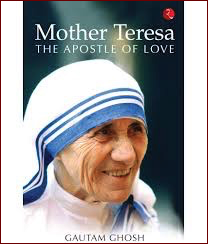
Indeed, being a cardinal is not a religious title. It is often a reward for your merits toward the Church. It’s an honor title. Rumors went in the past that Pope John Paul II wanted to create Mother Theresa cardinal. It would have been a recognition of her service to God and His Church. And don’t forget: only cardinals until 80 years old have the right to vote during the election of a new pope, the conclave. Mother Theresa was at the time of the rumors already over 80 years old; but it would have been a nice gesture. Other lay people became cardinal (even in pecture) like the theologian Hans Urs von Balthazar.
The first big changes in the government of the Vatican came under Pope Benedict XVI. He was the first to give lay women a prominent function within the curia (the highest organ within the Catholic Church). This change was continued by pope Francis I. Believe it or not, but the head of the most (paid) visited museum in the world, the Vatican Museums, is today in the hand of a women of my age: Dott.ssa Barbara Jatta ! And I can tell you, she is doing a fantastic job!

Conclusion

It’s not my task to make conclusions. But the artifacts of the Pius Christian Museum in the Vatican shows us a strong support for the position of women as teachers-deacons in the primitive church, just like the Pontifical commission for the Study of the Diaconate of Women concluded. And also, don't forget, four Women hold the title of Doctors of the Church: Hildegard of Bingen, Catherine of Siena, Teresa of Avila and Therese of Lisieux. Four women have been recognized by the Vatican as Doctors of the Church and thus form a part of the magisterium (authentic teaching authority) of the Roman Catholic Church.
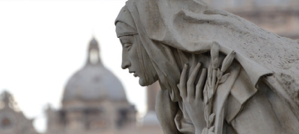


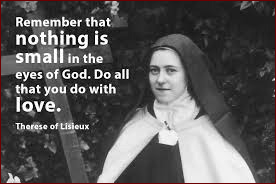
Pope Francis in 2017 raised the feast of saint Mary Magdalene to the same level as the feast of the Apostles. (click for reading the Osservatore Romano) Pope Francis decreed that the celebration of Mary Magdalene should be raised from an obligatory commemoration to a liturgical feast and from now onwards the Proper of the Apostles will been used in Mass on the 22 July. She is a witness, an Apostle.
Who knows what the future will bring us? In all my articles, I always try to bring a funny note. This time I made screen shots of a program of the BBC in the United Kingdom about Mary Magdalene. At the end of the program appeared, between each of the statues of the apostles on the Basilica Saint Peter a women. Is it possible that what today is photo-shopping would become one day a reality?
And here, women appear between the apostles on saint Peter’s Basilica
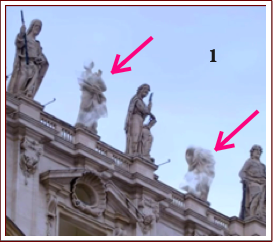
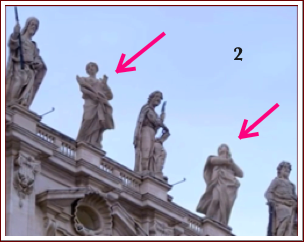

So, our last fundamental question will be: Me too ?
or ...
You too ? Are you ready to spread the Good News ?